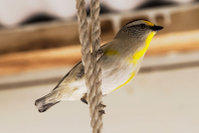| Pardalotes | ||||||||||||
|---|---|---|---|---|---|---|---|---|---|---|---|---|

Pardalotus striatus ornatus
|
||||||||||||
| Scientific classification | ||||||||||||
|
||||||||||||
|
Pardalotus punctatus Pardalotus quadragintus Pardalotus rubricatus Pardalotus striatus |
Pardalotes are very small, brightly coloured birds native to Australia, with short tails, strong legs, and stubby blunt beaks. They form part of the family Pardalotidae. The name derives from a Greek word meaning "spotted".
Pardalotes spend most of their time high in the outer foliage of trees, feeding on insects, spiders, and above all lerps (a type of sap sucking insect). Their role in controlling lerp infestations in the eucalyptus forests of Australia may be significant.
They generally live in pairs or small family groups but sometimes come together into flocks after breeding.
All four species nest in deep horizontal tunnels drilled into banks of earth. Externally about the size of a mouse-hole, these can be very deep, a metre or more. (Some species also nest in tree-hollows; see below for details.)
There are four species in the genus Pardalotus, with several sub-species.
Species
- Spotted Pardalote, Pardalotus punctatus.
Forty-spotted Pardalote, Pardalotus quadragintus.
Red-browed Pardalote, Pardalotus rubricatus
Striated Pardalote, Pardalotus striatus.
External links
- Pardalote videos on the Internet Bird Collection




 216.73.216.91
216.73.216.91 User Stats:
User Stats:
 Today: 0
Today: 0 Yesterday: 0
Yesterday: 0 This Month: 0
This Month: 0 This Year: 0
This Year: 0 Total Users: 117
Total Users: 117 New Members:
New Members:
 216.73.xxx.xx
216.73.xxx.xx
 Server Time:
Server Time: